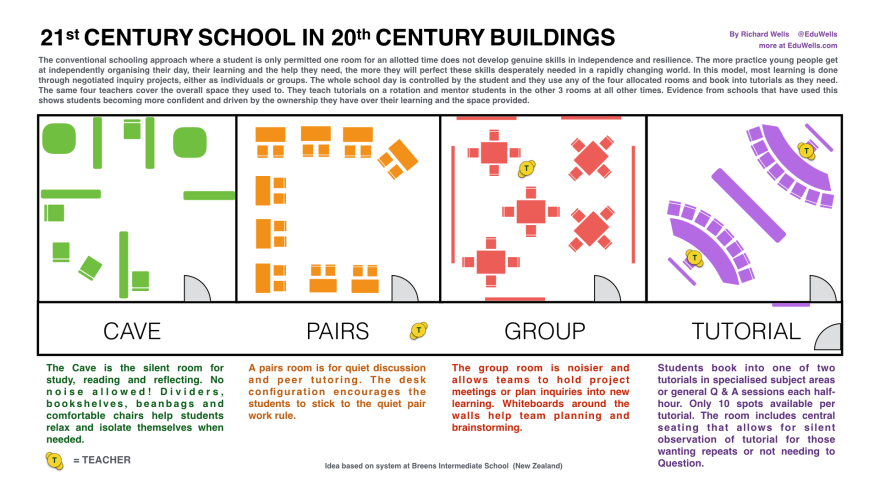![]()
|
Professional Learning Tool
|
|
|
The Professional Learning Tool describes the characteristics of a learner-centered environment by connecting the Teaching and Learning Framework with the focus areas of teacher, space, and student. These connections to the Charlotte Danielson Framework for Teaching and the Framework for 21st Century Learning supports teachers in using sound instructional practices that meet the needs of all students.
Possible Uses:
|
Download the Professional Learning Tool Download the Professional Learning Tool with Examples of Evidence
|
Classroom Arrangement |
|
|
Things to Consider for Room Arrangement:
1. "Maximize the layout of your room- If possible, arrange seats/tables/desks so that you can easily move among them and can see multiple screens at once. Some teachers have different arrangements for different activities (desks/seats facing the periphery during independent work, facing front during direct instruction), others use designated areas in the room for technology activities (like stations or centers), and others use mirrors around the room to provide multiple "eyes" in the room." From the Office of Instructional Technology in Cherry Creek Schools
http://techtips-ccsd.blogspot.com/2014/09/tuesday-tech-tips-7-classroom.html '
2. Be creative- Rethink the way your class is set up. Do you have learning spaces for students to work in small groups? large groups? independently? Are there learning spaces that don’t involve desks and chairs?
https://eduwells.files.wordpress.com/2015/11/21c-classroom-layout1.png?w=640&h=360
3. Be responsive- Listen to your students and change plans accordingly. Take advantage of student interests and ideas. Allow students to form groups and choose their learning space.
Quote from http://www.scholastic.com/teachers/2013/08/designing-your-classroom-space-and-after-photos
4. Make good use of space- Place learning materials in a location that all students can see and access easily. Create visuals for around the room in collaboration with students so that they are useful and serve a purpose.
Check out the BCPS ODL Pinterest Board
5. Avoid "the stage"- Avoid putting yourself "on stage" in the front of the room. Create an environment where you can move freely around the room and arrange furniture and materials so that you can collaborate with students and facilitate their learning experience
http://www.eit.edu.au/image/onlinebook/Sage-on-the-Stage-11.jpg
|
Additional Resources:
|
|
Blended Learning Models
|
|
|
Blended learning is an instructional delivery model in which the student accesses content and instruction through a blend of face-to-face interaction and digital learning opportunities.
Components of a blended classroom might include: accessing assigned digital content, collaborative work, formative or summative assessment, whole group instruction, independent activities, and small group instruction.
Using these components there is an endless number of potential pathways for students to move through. You will find five possible group pathways below. Remember, these are just some of the possible pathways.
Any of the pathways can be customized to meet the needs of the teacher or students in the class.
Download a copy of the Blended Learning Pathways
|
|
Terms & Definitions (Source: Modern Teacher)
|
Resources |
Learner-Centered Environment:
|
|
|
Customized Learning:
|
Customization - Chapter 6 (Source: Modern Teacher) |
|
Personalized Learning:
|
|
|
Blended Learning: (Source: BCPS, 2017)
|
Example Blended Learning Models
|
|
Flipped Learning:
|
|
|
21st Century Skills:
|
Partnership for 21st Century Learning Framework
|






